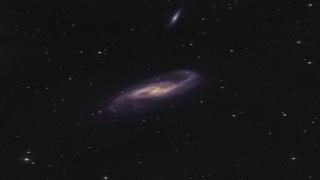Bibcode
Zaritsky, Dennis; Salo, Heikki; Laurikainen, Eija; Elmegreen, Debra; Athanassoula, E.; Bosma, Albert; Comerón, Sébastien; Erroz-Ferrer, S.; Elmegreen, Bruce; Gadotti, Dimitri A.; Gil de Paz, Armando; Hinz, Joannah L.; Ho, Luis C.; Holwerda, Benne W.; Kim, Taehyun; Knapen, J. H.; Laine, Jarkko; Laine, Seppo; Madore, Barry F.; Meidt, Sharon; Menendez-Delmestre, Karin; Mizusawa, Trisha; Muñoz-Mateos, Juan Carlos; Regan, Michael W.; Seibert, Mark; Sheth, Kartik
Referencia bibliográfica
The Astrophysical Journal, Volume 772, Issue 2, article id. 135, 16 pp. (2013).
Fecha de publicación:
8
2013
Revista
Número de citas
56
Número de citas referidas
50
Descripción
We study the m = 1 distortions (lopsidedness) in the stellar components
of 167 nearby galaxies that span a wide range of morphologies and
luminosities. We confirm the previous findings of (1) a high incidence
of lopsidedness in the stellar distributions, (2) increasing
lopsidedness as a function of radius out to at least 3.5 exponential
scale lengths, and (3) greater lopsidedness, over these radii, for
galaxies of later type and lower surface brightness. Additionally, the
magnitude of the lopsidedness (1) correlates with the character of the
spiral arms (stronger arm patterns occur in galaxies with less
lopsidedness), (2) is not correlated with the presence or absence of a
bar, or the strength of the bar when one is present, (3) is inversely
correlated to the stellar mass fraction, f *, within one
radial scale length, and (4) correlates directly with f *
measured within the radial range over which we measure lopsidedness. We
interpret these findings to mean that lopsidedness is a generic feature
of galaxies and does not, generally, depend on a rare event, such as a
direct accretion of a satellite galaxy onto the disk of the parent
galaxy. While lopsidedness may be caused by several phenomena, moderate
lopsidedness (langA 1rang i + langA
1rang o )/2 < 0.3) is likely to reflect halo
asymmetries to which the disk responds or a gravitationally
self-generated mode. We hypothesize that the magnitude of the stellar
response depends both on how centrally concentrated the stars are with
respect to the dark matter and whether there are enough stars in the
region of the lopsidedness that self-gravity is dynamically important.
Proyectos relacionados

Las Galaxias Espirales: Evolución y Consecuencias
Nuestro grupo pequeño esta bien conocido y respetado internacionalmente por nuestro trabajo inovativo e importante en varios aspectos de la estructura y la evolución de las galaxias espirales cercanas. Usamos principalmente observaciones en varias longitudes de onda, explotando las sinergías que nos permiten responder a las cuestiones más
Johan Hendrik
Knapen Koelstra